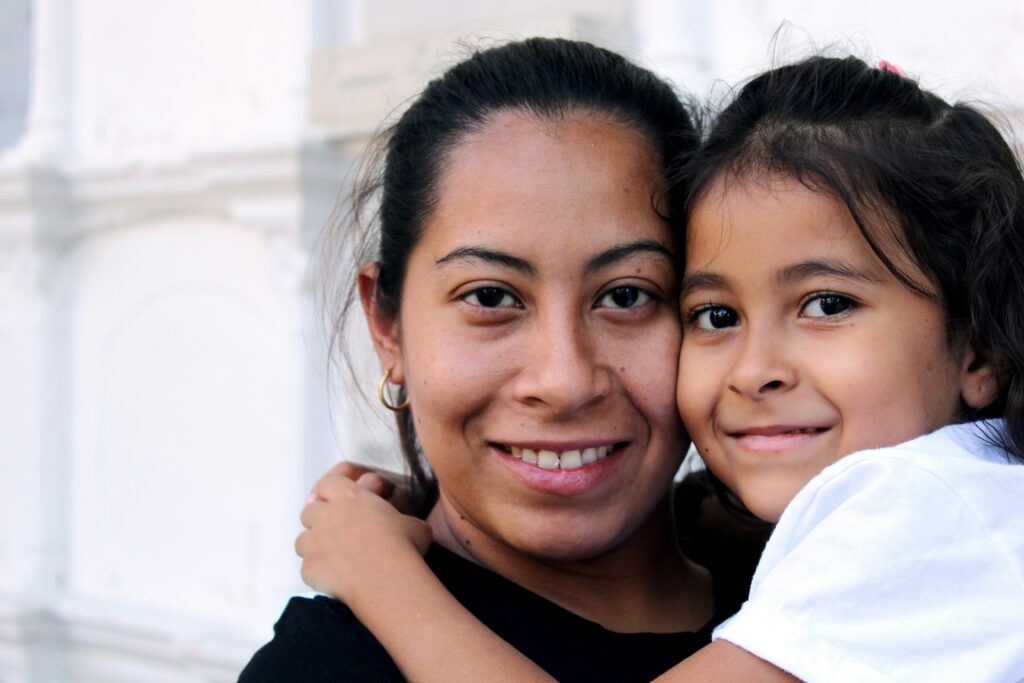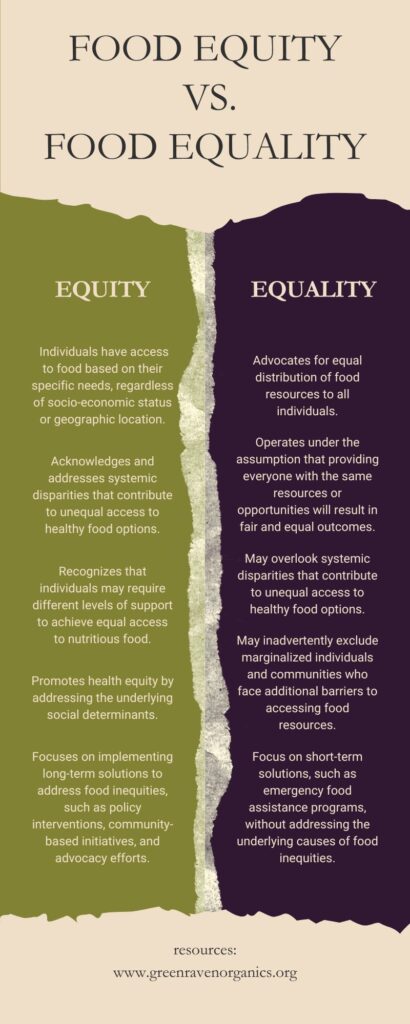In recent years, the concept of food equity has emerged as a critical focal point in discussions surrounding public health, social justice, and community well-being. At its core, food equity encompasses the idea that everyone, regardless of their socio-economic status or geographic location, should have access to nutritious and affordable food options. It’s important to know that there are systemic disparities that contribute to food deserts, food insecurity, and nutrition disparities within our communities.
The importance of comprehending food equity extends far beyond individual health outcomes; it is intrinsically linked to broader issues of economic inequality, social justice, and sustainable food systems. By looking into the complexities of food equity, we can unearth the root causes of food inequities and create meaningful strategies to support a more equitable and inclusive food landscape for all. In this blog, we will explore the multifaceted nature of food equity, unpacking its significance and implications for individuals, communities, and society as a whole.
The Concept of Food Equity
The concept of food equity has gained increasing attention as a fundamental principle essential for promoting public health, social justice, and community well-being. Food equity revolves around the notion that every individual, regardless of their socio-economic status or geographic location, should have access to nutritious and affordable food options. However, achieving food equity requires a deeper understanding of the complex factors that contribute to food inequities and disparities within our communities.
The 3 Key Components of Food Equity
1. Access to Nutritious Food

One of the primary components of food equity is ensuring universal access to fresh, healthy, and affordable food options. Many communities across the country face significant barriers to accessing nutritious food, often resulting in the emergence of food deserts. Food deserts are areas where residents lack access to grocery stores or supermarkets that offer a variety of fresh produce and healthy food options. These communities are disproportionately populated by low-income individuals and people of color, perpetuating cycles of poverty and poor health outcomes.
2. Economic Factors

Individuals and families with limited financial resources may struggle to afford nutritious food, leading to reliance on cheaper, processed options that are often high in calories and low in nutritional value. Income disparities and economic inequality increase these challenges, making it difficult for marginalized communities to access healthy food options. Addressing economic barriers to food access, such as increasing the availability of affordable produce and implementing food assistance programs, is essential for promoting food equity and ensuring that everyone has the opportunity to lead a healthy lifestyle.
3. Social Justice Implications

Food equity is closely intertwined with broader issues of social justice, including racial and ethnic disparities, systemic discrimination, and historical injustices. Many marginalized communities, particularly communities of color, have been disproportionately affected by food inequities and food insecurity due to systemic racism, discriminatory policies, and economic exploitation. These social determinants of health contribute to significant disparities in health outcomes, with marginalized communities experiencing higher rates of diet-related diseases, such as obesity, diabetes, and heart disease. Addressing the root causes of food inequities requires acknowledging and dismantling structural barriers to food access and advocating for policies that promote equity and justice for all individuals.
Contrasting Food Equity with Food Equality

While food equity and food equality are often used interchangeably, they are distinct concepts with different implications for addressing food inequities. Food equality focuses on providing everyone with the same resources or opportunities, regardless of their individual circumstances or needs. In contrast, food equity recognizes that individuals may require different levels of support to achieve equal access to nutritious food. This distinction is crucial in developing effective strategies to address food inequities and ensure that everyone has the opportunity to lead a healthy and fulfilling life.
The Impact of Food Inequities
Food deserts are geographic areas where residents have limited access to affordable and nutritious food options, particularly fresh fruits, vegetables, and whole grains. These areas are typically characterized by the absence of grocery stores or supermarkets within a reasonable distance, forcing residents to rely on convenience stores, fast food outlets, or other sources for their food needs. Food deserts disproportionately affect low-income communities and communities of color, exacerbating existing health disparities and contributing to adverse health outcomes. Understanding the prevalence and impact of food deserts is crucial for addressing food inequities and promoting health equity within our communities.
Effects of Food Insecurity on Individuals and Communities

Food insecurity, the inability to consistently access adequate food for an active, healthy life, has far-reaching consequences for individuals and communities. Individuals experiencing food insecurity often face challenges in maintaining a balanced diet, leading to increased risk of malnutrition, obesity, and chronic diseases. Food-insecure households may also experience psychological stress, anxiety, and depression related to uncertainty about where their next meal will come from. In addition to its effects on individual health, food insecurity can strain community resources, increase healthcare costs, and perpetuate cycles of poverty and inequality. Addressing food insecurity requires comprehensive strategies that address the root causes of poverty, improve access to nutritious food, and promote economic stability for all individuals and families.
Health Disparities and Nutritional Outcomes

Food inequities contribute to significant health disparities and disparities in nutritional outcomes among different populations. Individuals living in food deserts and experiencing food insecurity are more likely to consume diets that are high in processed foods, sugar, and unhealthy fats, while lacking essential nutrients like vitamins, minerals, and fiber. These dietary patterns increase the risk of obesity, diabetes, heart disease, and other diet-related diseases, particularly among marginalized communities. Addressing health disparities and improving nutritional outcomes requires interventions that go beyond simply increasing access to healthy food options. It involves addressing the social determinants of health, promoting health equity, and empowering individuals and communities to make healthier choices.
Factors that Contribute to Food Inequities
Economic Factors
Income Inequality
Income inequality plays a significant role in perpetuating food inequities, as individuals and families with lower incomes often face greater challenges in accessing healthy and affordable food options. Limited financial resources can constrain food choices and force individuals to prioritize cheaper, less nutritious foods over fresh produce and whole grains.
Cost of Healthy Food Options
The cost of healthy food options is another economic barrier that contributes to food inequities. In many communities, fresh produce and whole foods are more expensive than processed and unhealthy alternatives, making it difficult for low-income individuals to afford nutritious meals. As a result, individuals living in poverty or on fixed incomes may be forced to compromise their dietary quality in favor of affordability.
Social Factors
Race and Ethnicity
Race and ethnicity are significant determinants of food inequities, with communities of color disproportionately affected by limited access to healthy food options and higher rates of food insecurity. Structural racism and discriminatory policies have historically marginalized communities of color and perpetuated disparities in food access and availability.
Geographic Location
Geographic location plays a crucial role in determining access to healthy food options, with residents of rural and urban areas facing unique challenges. Rural communities may lack grocery stores and supermarkets, while urban areas may be characterized by the presence of food deserts and limited access to fresh produce. Additionally, the distribution of food retailers and resources may be unevenly distributed, further exacerbating disparities in food access.
Access to Transportation
Access to transportation is a critical determinant of food access, particularly for individuals living in areas with limited public transportation options. Without reliable transportation, individuals may struggle to travel to grocery stores or supermarkets, especially in rural or underserved areas. Limited access to transportation can exacerbate food inequities and contribute to higher rates of food insecurity among vulnerable populations.
Policy and Systemic Barriers
Lack of Government Support
The lack of government support and investment in addressing food inequities is a significant barrier to promoting food equity. Many communities lack access to essential resources and services, such as grocery stores, farmers markets, and food assistance programs, due to inadequate funding and policy priorities. Additionally, policies that perpetuate inequalities in food access, such as zoning regulations and subsidies for unhealthy foods, further exacerbate food inequities.
Food Distribution Systems
The structure of food distribution systems can also contribute to food inequities, particularly in terms of the availability and affordability of nutritious food options. Industrialized food production and distribution systems often prioritize efficiency and profit over public health and environmental sustainability, resulting in disparities in food access and availability. Additionally, inequities in food distribution can perpetuate disparities in food access between rural and urban areas, as well as between affluent and low-income communities.
Addressing Food Inequities
Community Based Solutions
Urban Gardening Initiatives

Urban gardening initiatives play a crucial role in addressing food inequities by empowering communities to grow their own fresh produce and establish sustainable food sources. Community gardens provide residents, particularly those in urban areas and food deserts, with access to nutritious fruits and vegetables, promote environmental stewardship, and foster social connections. By creating spaces for community engagement and education, urban gardening initiatives empower individuals to take control of their food systems and improve food access in their neighborhoods.
Farmers Markets and Community-Supported Agriculture (CSA)
Farmers markets and community-supported agriculture (CSA) programs are valuable resources for increasing access to fresh, locally grown produce and supporting small-scale farmers. Farmers markets provide communities with direct access to local growers and producers, allowing consumers to purchase fresh, seasonal produce while supporting local economies. Similarly, CSA programs offer consumers the opportunity to purchase shares of a farm’s harvest in advance, receiving regular deliveries of fresh produce throughout the growing season. By promoting direct relationships between consumers and farmers, farmers markets and CSA programs contribute to food equity by bypassing traditional food distribution channels and ensuring that farmers receive fair compensation for their products.
Policy Interventions
Government Subsidies for Healthy Foods
Government subsidies for healthy foods can help make nutritious options more affordable and accessible to low-income individuals and families. By providing financial incentives for the production and purchase of fruits, vegetables, and other healthy foods, governments can encourage healthier dietary choices and reduce the financial barriers to healthy eating. Additionally, targeted subsidy programs can help address disparities in food access and support communities that are disproportionately affected by food inequities.
Zoning Regulations to Prevent Food Deserts
Zoning regulations play a critical role in shaping the food environment and can be leveraged to prevent the emergence of food deserts and promote equitable access to healthy food options. By implementing policies that prioritize the establishment of grocery stores, farmers markets, and other food retail outlets in underserved areas, governments can ensure that all residents have access to nutritious food within their communities. Zoning regulations can also address issues such as food advertising, land use, and urban planning to create environments that support healthy eating and active living.
Collaborative Efforts
Non-profit Organizations and Grassroots Movements
Non-profit organizations like Green Raven Organics and grassroots movements are instrumental in addressing food inequities through community-based initiatives, advocacy campaigns, and direct service provision. These organizations work tirelessly to raise awareness about food insecurity, mobilize resources, and implement innovative solutions to improve food access and nutrition. From operating food pantries and mobile markets to advocating for policy change and supporting urban agriculture projects, non-profit organizations and grassroots movements play a vital role in creating more equitable and sustainable food systems.
Corporate Social Responsibility Initiatives
Corporate social responsibility (CSR) initiatives offer opportunities for businesses to contribute to the fight against food inequities and support community health and well-being. Through partnerships with non-profit organizations, philanthropic investments, and sustainable business practices, corporations can make meaningful contributions to addressing food access issues and promoting health equity. CSR initiatives may include initiatives such as employee volunteer programs, food donation partnerships, and investments in community development projects aimed at improving food access and nutrition education. By aligning their business goals with social and environmental objectives, corporations can play a positive role in advancing food equity and building healthier communities.
The Green Raven Organics Mobile Markets Initiative
Green Raven Organics’ Mobile Markets initiative is a community-centered approach to addressing food inequities and increasing access to fresh, locally sourced produce. Through our Mobile Markets, we bring nutritious food directly to underserved neighborhoods, eliminating barriers such as transportation challenges and limited access to grocery stores. Our Mobile Markets feature a variety of fruits, vegetables, and other healthy food options, sourced from local farmers and producers whenever possible. By partnering with community organizations, schools, and housing developments, we are able to reach individuals and families who may otherwise struggle to access fresh, healthy food. The Mobile Markets initiative not only provides essential nutrition to those in need but also fosters a sense of community and connection, empowering individuals to make healthier choices and build a more resilient food system.
Promoting Food Equity: What You Can Do
Supporting Local Food Initiatives
Supporting local food initiatives, like our Mobile Markets, is a powerful way to promote food equity and strengthen community food systems. By purchasing from local farmers markets, joining community-supported agriculture (CSA) programs, or patronizing businesses that prioritize sourcing from local producers, individuals can contribute to a more resilient and equitable food system. Additionally, participating in urban gardening projects, community gardens, and food cooperatives can help increase access to fresh, nutritious food and foster community resilience.
Advocating for Policy Change
Advocating for policy change is essential for addressing systemic barriers to food equity and promoting more inclusive and sustainable food systems. Individuals can advocate for policies that support equitable access to healthy food, such as zoning regulations that incentivize the development of grocery stores and farmers markets in underserved areas, or initiatives that increase funding for nutrition assistance programs. By engaging with policymakers, signing petitions, and participating in advocacy campaigns, individuals can help shape policies that promote food justice and address the root causes of food inequities.
Volunteering with Organizations Addressing Food Insecurity
Volunteering with organizations addressing food insecurity is an impactful way to directly support individuals and communities in need. Whether through food banks, meal delivery programs, or community kitchens, volunteers play a vital role in distributing food to those experiencing hunger and food insecurity. Additionally, volunteering with organizations that focus on education, advocacy, and community empowerment can help address the underlying causes of food inequities and promote long-term solutions to hunger and poverty.
Raising Awareness and Educating Others
Raising awareness and educating others about food equity issues is essential for building a more informed and engaged community. Individuals can use their platforms, whether online or in-person, to share information about food inequities, the impact of systemic racism on food access, and solutions to address hunger and poverty. Hosting educational events, organizing workshops, and participating in community discussions are effective ways to raise awareness and mobilize support for food justice initiatives. By amplifying marginalized voices and advocating for change, individuals can contribute to building a more just and equitable food system for all.
Empowering Communities, Building Equity
Food equity is not just about ensuring access to healthy food; it’s about empowering communities, dismantling systemic barriers, and fostering social justice. Food equity is a fundamental human right, and achieving it requires collective action, advocacy, and collaboration at every level of society.
From addressing economic disparities to advocating for policy change, there are numerous ways individuals can contribute to the fight against food inequities. By supporting local food initiatives, volunteering with organizations addressing food insecurity, and raising awareness about food equity issues, we can all play a role in building a more just and equitable food system.
Together, we can create a future where everyone has access to fresh, healthy food, regardless of their socio-economic status or geographic location. By working together and advocating for change, we can build a more equitable and sustainable food system for generations to come. Join us in our mission to create a world where food equity is a reality for all.




0 Comments